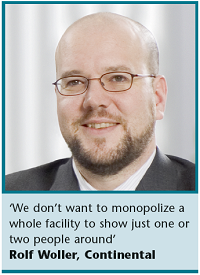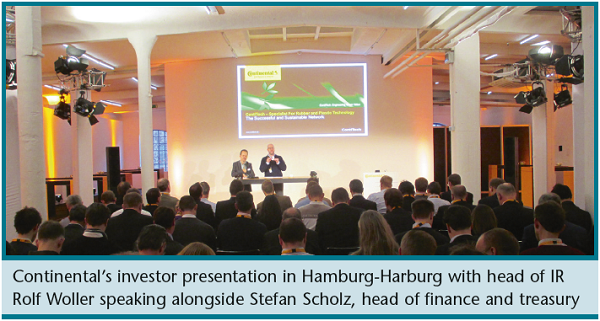IR teams are joining forces with peers – and even rivals – to meet investors and make their efforts go further
Teaming up with IR professionals from outside your own company might seem like an unusual initiative to begin with, but doing so can open up new opportunities, expand the shareholder base and even give the C-suite an insight into how things are done elsewhere.

Relations between the IR heads at the six big Canadian banks are good, says Peter Slan – the self-described ‘dean of the Canadian banking IR heads’ – who has led the IR department at Scotiabank for the past five years.
‘All of the heads of investor relations at the Canadian banks know each other well: we see each other at events and have dinner a couple of times a year to talk about best practices and so forth,’ he explains. ‘It’s collegial but of course we’re also competitors – we’re the original ‘frenemies’. When we get together we’re largely talking about processes and best IR practices; we’re really not talking about what our own institutions are up to – that’s seen as being a bit more competitively sensitive.
Last year, Slan, along with the heads of IR from TD Bank and Royal Bank of Canada, took this innovative relationship even further with a shared expedition to meet analysts in Atlanta. ‘Our trip was largely driven by one of the sell-side analysts, who came up with the idea of asking the IR heads of the three largest Canadian banks to come down to the US market,’ Slan says.

This wasn’t a conference on the Canadian banking sector, however. ‘This was me presenting on Scotiabank, and my competitors presenting on their institutions. It was a series of separate but consecutive one-on-ones – so a group of investors came in and met with me for an hour and then they met with one of my competitors and so forth,’ Slan explains.
‘Each of us got to see between seven or eight investors over the course of the day and tell our story. From the investors’ perspective, they got to hear three separate stories from three different Canadian banks – and then hopefully went home and placed an order for some Scotiabank shares!’
So what was the appeal of Atlanta over the more obvious, traditional destinations? For a start, both New York and Boston are included in the regular marketing schedules for the big banks. ‘Atlanta is a secondary market that doesn’t get a lot of visits from Canadian companies so it’s a great opportunity for investors that we don’t see regularly to see us, hear our story and compare us with some of our chief competitors,’ Slan points out.
What’s more, while Atlanta might not be a particularly large financial center, ‘it is nevertheless a terrific market – it’s sort of the financial hub of the South – so that was attractive to us,’ Slan adds. ‘We went with a sell-side firm that has a big US capability.’
Spreading the word
These events, which are used for targeting non-domestic shareholders, are a great opportunity for the firm to ‘communicate the Scotiabank story to non-Canadian investors,’ says Slan.
‘All Canadian banks have large domestic banking operations in Canada, but beyond that we differentiate ourselves through differing strategies. In Scotiabank’s case, we call ourselves Canada’s most international bank. And we’ve seen some success from [these events]. Our non-Canadian shareholder base has increased by a couple of percentage points over the last year and I think that’s a direct result of not only this trip but also all of our non-Canadian marketing activities.’
Talking about plans for similar events in the future, Slan says finding a date suitable for the three banks has been the main challenge. ‘I shouldn’t speak for my competitors but at Scotiabank we’re certainly open to [doing more of these joint events] and I would like to think the others are, too,’ he says.
Slan is keen to broaden his outreach to new locations, ‘markets that we don’t go to in the ordinary course of events. We have one or two conferences in New York that we participate in each year and we generally go down to Boston annually because that’s a hub with a lot of institutional investment capital.
‘There are, however, plenty of other markets – in the US, in particular – that have large pockets of capital but that we get to only periodically. It’s one of those markets that we’d likely consider for the next similar event.’
Gearing up
Joining forces, not with competitors, but rather with complementary companies from the sector, has also been a tactical solution favored by German tire maker Continental. Rolf Woller, head of IR at the Hanover-based firm, which won the best investor meetings category at the IR Magazine Awards – Europe 2014, explains that two years ago his team introduced a yearly analyst and investor meeting to coincide with Q3 results, when the firm’s budget has been finalized.
‘Last year we used this opportunity to introduce our ContiTech division to the financial community, and this year the event took place in Regensburg at our powertrain division and headquarters,’ Woller details. But even though ‘everybody wants to see your operations’, getting a suitable number of attendees for a site visit can sometimes present a challenge.
‘Time and budget constraints might actually limit the number of participants to a level where it is hardly worth the effort,’ Woller points out. ‘We don’t want to end up monopolizing a board member and a whole facility to show just one or two people around.’
This is where the teaming up comes in. ‘Offering a joint event with our colleagues from the sector makes it time-efficient for investors, as they can see several companies all in one trip. We also get the benefit of a larger number of attendees,’ Woller says, adding that the most attractive happenings are planned well in advance – such as an event planned with Daimler, ‘which was unfortunately postponed due to unfavorable weather.’ 
Transatlantic IR
Over in the retail sector, Matt Duffy, investor relations manager at Kingfisher – the largest home improvement retailer in Europe – has teamed up with US counterparts at Home Depot and Lowe’s, a relationship that works to the advantage of companies on both sides of the Atlantic.
Despite having no operations in the States, half of Kingfisher’s shareholder base is now in the US, explains Duffy, so the company holds a biannual investor event, alternating between London and New York. While Duffy highlights that his firm has ‘not partnered with US peers on investor engagement as such’, this year Kingfisher followed its New York event with a tour of Home Depot and Lowe’s stores for eight of its regional CEOs, the group chief executive and CFO. Such tours are informal events, he explains, with executives looking at ‘what the US retailers are doing with iPads in store, what they’re doing with omni-channel [marketing].’

Home Depot and Lowe’s also visit Kingfisher’s outlets when they go to Europe. ‘We have an ongoing friendly relationship with our US counterparts,’ Duffy notes. ‘We don’t compete in any geographies so we are all happy to show each other around stores and meet informally on occasion.’ He adds that his firm’s ScrewFix store format attracted a lot of US interest.
Duffy relates that before he joined the firm, ‘management went to Home Depot’s headquarters and met with the management team there, and it gave us a very high-level presentation.’
These exchanges with non-competing peers in the US aren’t the only examples of Duffy and his IR colleagues at Kingfisher teaming up with others in the same industry, however. He reports that the UK’s retail IR professionals also regularly get together to discuss IR issues, in much the same way as the Canadian banks do.
‘There is a quarterly meeting with up to 10 UK retail IROs that we call the IR Forum,’ he says. ‘Again, it’s not talking about our companies or strategy, but more about who is going on roadshows where, which brokers are good in which cities, which shareholder analysis providers look best. And then once a year we also invite all the retail sector analysts out for a drink – because obviously they’re usually the ones taking us out.’
|
IR around the world |










